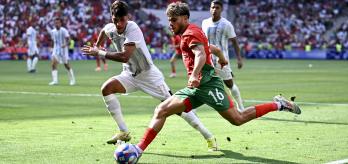Former France international and current Technical Study Group (TSG) member Ibrahim Ba attributes Spain’s tournament success to several factors. “Spain always kept their composure and were consistent in how they played. They had a clear playing style in and out of possession, with similar and identifiable patterns of play. They controlled their games and often seemed to be orchestrating plays that were one or two actions ahead of their opponents. Every time a player was on the ball, other players were moving to create space and make offers to receive, meaning that receiving players already knew what they would do with the ball before they received it. At times, other teams struggled with this speed of thought and game intelligence because Spain also had players with the technical abilities to execute passes accurately, even when under direct pressure.”
In possession
Spain liked to dominate the ball and spent 53.4% of their time in possession in the build-up phase, the second most of any team at the tournament. They were also ranked second for percentage of time spent in the progression phase (26.5%) and were lowest of all 16 teams for percentage of in-possession time spent in counter-attacks (0.79%). When building their play, they were ranked number two in the tournament for offering movements to receive in between the lines of their opposition’s team shape, with an average of 52.2 per 30 minutes in possession.
The gold medalists also completed more line breaks by passing than any other team, with 115.9 passes completed per 30 minutes in possession. They were also ranked first for forward passes completed (287.5) and had the lowest number of possession sequences (129 per 30 minutes in possession) indicating how well they could maintain possession once they had it. When it came to playing deep inside the opposition’s half, only France received the ball more times (with 171.6) inside the final third than Spain, who accumulated an average of 145.6 receptions in this area of the field per 30 mins in possession.
Creating space and numerical supremacy
Kirsty Yallop explains how Santi Denia’s side achieved these exceptional in-game statistics.
“The movement and rotations of Spain’s three central midfielders were crucial in how they progressed the ball from build-up phase to the final third. Opposition teams really struggled to contain and track their movements or to stop them from accessing the big spaces they were able to create. Movements to receive by players ahead of the ball dragged opposition defenders into parts of the pitch they did not want to be, and Spain’s attacking players were very effective at penetrating those spaces left vacant in the distorted defensive lines,” she explained.
“It was very impressive to watch, especially because their players are so technically capable of receiving the ball with quality touches and playing accurate passes in tight spaces, when under direct pressure. As we see in the clips below, they looked a very accomplished team.”
In clip 1, we see how Spain patiently build their play before creating an 8v4 numerical advantage in the wide area. They do this by bringing a centre-back and the three central midfielders into the wide channel to support their full-back and wide forward that are occupied by opposition players. Even when the opposition team regains numerical parity around the ball, Spain gain numerical supremacy ahead of the ball using the positioning of the wide forward and centre-midfielder to create the 2v1 against Japan’s left-back.
In clip 2, we see how Spain use two central midfielders to create a numerical overload in their build-up play. As the play starts, Pablo Barrios (6) is already positioned deep as a pivot player. As soon as Japan initiate their high press, Álex Baena (10) drops down as a second pivot player, offering to receive from his goalkeeper, vacating a huge area of space in the process. Once he receives and turns with the ball, his left-back Juan Miranda (3) makes a supporting run into that space and advances 50 metres completely unopposed before passing.
And in clip 3, we see an excellent example of the consistent movements and offers to receive made by Barrios, Baena and Fermín López (11). The relationships and connection between the three midfielders are evident as they move to create overloads in their defensive and forward lines, while their team-mates work to build and progress their possession. Using consistent movements to support, create angles and disturb opposition defensive lines, Baena eventually assists Fermín, whose forward run creates an overload facilitating this unopposed goal-scoring opportunity.
Out of possession
Spain did not have one singular policy when it came to defending. Instead, they had different approaches for different phases of their opposition’s possession: against opposition goal kicks, La Roja implemented a high press; when they lost the ball, they were aggressive at initiating counterpressure when it was possible and wise to do so.
As is usual, most of their out-of-possession time was spent in collective low and mid-blocks however their players demonstrated the willingness to defend in different ways and the wisdom to know what approaches best suited certain in-game situations. Regardless of which defensive phase they were operating in, Spain ranked first for direct pressures applied, with 62.5 per 30 minutes out of possession, and third for number of defensive actions and tackles, averaging 133.7 for the former and 41 for the latter.
According to Yallop, “Spain made their own luck and proved to have effective ways of defending in different situations. They were compact and effective when defending in blocks, even though sometimes, particularly in the final against France, they dropped off too much and invited pressure. However, as we see in the clips below, when defending in mid- and low blocks, they kept a good defensive structure and operated in a coordinated way, working off specific triggers. Each player knew when to apply pressure, when to push on to support pressure and when to drop off and protect space. It is very notable though, just how committed the players are once they go to apply direct pressure.”
Goalkeeper
The goalkeeper plays a pivotal role in every team and for Spain, 23-year-old Arnau Tenas (23) proved to have a big influence on their journey to Olympic gold. Pascal Zuberbühler leads the goalkeeper analysis in FIFA’s TSG, and here he highlights some of the crucial moments and aspects of Tenas’s personality that made a difference at key times throughout the tournament.
Mentality
“Every great goalkeeper must have a great personality and presence and be able to show up for their team in big moments of big games. With Tenas, we saw this on many occasions, but particularly his role in the Gold Medal Match was crucial,” Zuberbühler explained.
As we see in clip 6 below, Spain conceded in the 11th minute against France, with Tenas making an error of judgement when dealing with Enzo Millot’s (12) attempt at goal. Mistakes in big moments of big games can unravel goalkeepers, but Zuberbühler highlights the strength of character and mindset displayed by Tenas in his performance for the remainder of the game.
“Mistakes like this can feel very big for a goalkeeper, especially in games where the opposition team has such big support, but how he refocused and moved on from this moment shows real strength in his mentality. His team recovered by scoring three goals in the first half but just before the half-time whistle there was a very big moment in injury time, where he made a difficult and crucial save. In clip 7 we see how he continuously gets set and resets as France’s attacking phase develops. His concentration is very high, and he has put the mistake behind him. As the ball gets played wide, he makes a crucial positional adjustment towards his first post and higher from his goal. This positioning was the reason he could make the save from such a close-range attempt at goal and protect his team’s two-goal lead at the interval,” Zuberbühler explained.
“He didn’t have a huge amount to do in some games but in the big moments he showed up for his team, even after the mistake. He came back, and he had to come back himself and did it in his home stadium, because he plays also for PSG so maybe in this environment, he felt comfortable, even though France were the home team. His response to the early error was very impressive and this mentality is very important for goalkeepers.”
Crucial saves
Making big saves is the main role for a goalkeeper and these moments can be the difference between winning and losing. In the 71st minute, Tenas made another crucial save for his team.
As Zuberbuhler explains, “In clip 8, Tenas makes another important save, when the game was still 3-1 to Spain. We can see he stays close to his goal line and has a clear view of the how the France attack is developing. When Kone (6) breaks into the penalty area, Tenas is already set at his first post and makes a very explosive action to get down low to his right, using a strong outstretched hand to push the ball away. This is a very big save, especially because the strike at goal is made with such pace and power. His reactions and explosivity are very impressive.”
In clip 9, we see another crucial save by Tenas, from their quarter-final game against Japan. Spain lose possession on the edge of their penalty area, but Tenas’s concentration levels are very high, and he is ready to react. As soon as he realises his defender is beaten, he recognises the 1v1 situation and advances towards Mao Hosoya (11). These steps forward help make Tenas bigger and decrease the on-target options for Japan’s winger. Tenas gets set and makes an outstanding save with his left hand, pushing the ball just wide of his goal.
According to Zuberbühler, “Tenas is a big-game goalkeeper and has the personality, focus and mentality to make big saves at crucial moments. He wins points for his team and keeps them in games. His positioning and decision-making are very good, and he has the physical agility and explosivity to react sharply when needed.”
Distribution
Another feature of Tenas’s performance that impressed Zuberbühler was his quick decision-making and distribution. In the final against France, the Spanish goalkeeper had another contribution that again demonstrated his quick thinking, game intelligence and mentality.
In the dying moments of extra-time, Spain had a delicate 4-3 lead and were defending resolutely as France piled forward to try to get the equaliser that would send the game to penalties. As can be seen in clip 10 below, with eight France players encamped in and around Spain’s penalty area, an attack broke down. With such little time remaining, Tenas could easily have let the ball go out of play to run down the clock and restart play from a goal kick. However, his engagement with the game was so high that he recognised a brilliant counter-attacking opportunity.
Seeing that his forward Sergio Camello (21) was ahead of France’s last defenders (in his own half), he gathered the ball and ran towards the edge of the penalty area, giving Camello the opportunity to start running into the huge space ahead of him. Tenas threw a beautifully weighted long pass forward straight into Camello’s path, meaning the forward did not have to break his stride before scoring with his second touch of the ball.
As Zuberbühler explains, “This was game intelligence at the highest level, and it sealed the win for Spain. His vision and execution of the pass were brilliant, but once again, what I love here is his mentality. Instead of letting the ball go out of play and slowing things down to kill time, he recognised an opportunity to take all the pressure off his team and single-handedly created a goal-scoring opportunity. His communication and awareness of Camello’s positioning in relation to France’s last defenders, shows just how engaged he was and demonstrated a very strong winning mentality.”
Summary
Spain had clear ways of playing, both in and out of possession, that were in direct response to the phase of play their opposition were currently in. Their players were collective and diverse in the range of solutions they activated with strong decision-making skills and game intelligence. They knew how to create space and exploit it against different defensive structures, with their three central midfielders working tirelessly to activate overloads against opposition defensive lines.
Even when operating in tight spaces and under intense direct pressure, their players demonstrated the technical skills to be able to move and receive the ball, progressing their play in well-crafted attacking patterns. In addition, they displayed a strong ability to bounce back from setbacks in games, showing personality and a clear winning mentality.
Even when Spain rotated players and made substitutions, the cohesion in their play was not diminished or affected. Subs coming on often made strong impacts on games and this was a consistent feature of their successful Olympic campaign.





























